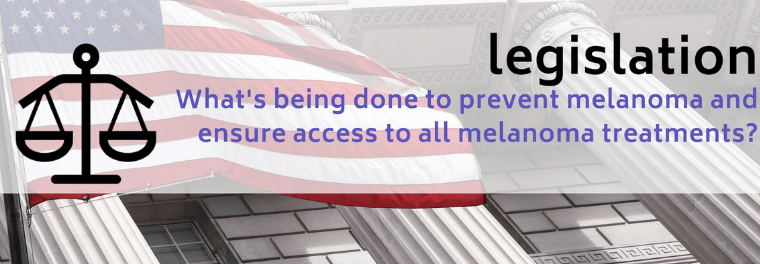Melanoma Legislation: Progress Report


The facts are straightforward:
Indoor tanning before 18 years of age increases one’s risk of melanoma by 85%,1 and the risk increases with each use.2
Despite these clear dangers, nearly 2.3 million adolescents tanned annually in 2005,3 and we know from recent studies that many children begin their indoor tanning with a family member, often their mother.4
In 2005, only a small handful of states banned minors from indoor tanning, and these states banned only some minors—such as those under 14. The vast majority of states had no restrictions or simply required parental consent.
The message was not getting out.
Enter AIM at Melanoma, which was founded in 2004. AIM’s goal? Pass an Under 18 Indoor Tanning Ban in every state in the United States.
Convincing legislators across the country to write and pass this type of legislation has not been easy—there are so many other efforts that vie for their attention and, frankly, get them better press. Additionally, the indoor tanning industry is formidable, and they’ve fought this legislation in every state, sometimes employing multiple lobbyists and flying in their “experts” to testify.
But with AIM at Melanoma leading the effort, California in 2011 became the first state to pass legislation to ban all minors from indoor tanning devices. In 2012, Vermont followed suit.
And AIM has continued to pursue its goal. Since 2011, 19 states and the District of Columbia have passed similar legislation.
The laws are working. A study of California tanning establishments found that 77% told an underage caller that she could not use their tanning facility. In Texas, where AIM led the effort to pass an Under 18 Indoor Tanning Ban in 2013, a study found that 81% of facilities complied with the ban. In Minnesota and Vermont, states that have passed an Under 18 Ban, the impact of their laws is already noticeable, with a dramatic decline in the number of high schoolers using tanning devices, according to the Youth Risk Behavior Surveys in their respective states.
AIM continues the quest to pass legislation in all 50 states, and in 2018 Rhode Island and New York became the latest states to ban indoor tanning for those under 18. New York’s situation was interesting: Several years ago, AIM had pushed for an under 18 bill, and in a compromise to get legislation passed, the state passed a bill banning minors under 17 from indoor tanning, and several other states followed suit with the under 17 compromise, including Pennsylvania. But many people felt that leaving out 17-year-olds—high school juniors and seniors—was leaving out the heaviest minor users of indoor tanning and leaving that population vulnerable. So there was a strong push to change New York’s law to the full Under 18 Ban, and the battle was won earlier this year.
AIM is already looking forward to 2019 and the fight for Under 18 Bans in Maryland, Michigan, Mississippi, Missouri, Montana, Nebraska, Utah, and Pennsylvania, where we’ll push to include 17-year-olds in the ban, just as in New York. AIM knows from experience that these bills will not be easy to pass, but the lives of our children are at stake, and we won’t rest until our goal of full Under 18 Bans in every state is achieved.
Beyond tanning, another legislative priority of AIM’s is to ensure that patients, families, and their medical providers are able to make treatment options irrespective of cost of the treatment. However, discrepancies in health insurance policies sometimes prohibit access to oral treatments due to cost.
Traditionally, anti-cancer medications administered intravenously or via injection are covered under a health plan’s medical benefit, only requiring patients to pay a moderate co-pay, or in some cases, no cost at all for the medication. However, oral anti-cancer medications are sometimes part of a health plan’s pharmacy benefit, which requires patients to pay a percentage of the overall cost of the prescription drug, resulting in high, burdensome out-of-pocket costs. As a result, patients may not take the oral treatment in accordance with the dosing requirements or may not to take the oral treatment at all.
In 2018, AIM continued to support legislation on the state and federal level to eliminate this discrepancy so that patients who prefer to take oral drugs as to opposed to an IV or injected treatment will have that option.
Advocating for tanning legislation and fairness in treatment options takes a small army of volunteers in each state, and AIM welcomes all who are interested in joining these fights. We have a legislation toolkit we can email you to get you started. If you are interested in supporting the effort in your state or any other, please email Sam Guild at sguild@AIMatMelanoma.org.
Recent Posts

Behavioral Addiction Responsible for Excessive Indoor Tanning

Announcing AIM at Melanoma’s Official Sunscreen Partner, WearSPF

Red Hair Genetics: 5 Things You May Not Know

Surviving & Thriving: From Melanoma Survivor to Sun Safety Advocate


